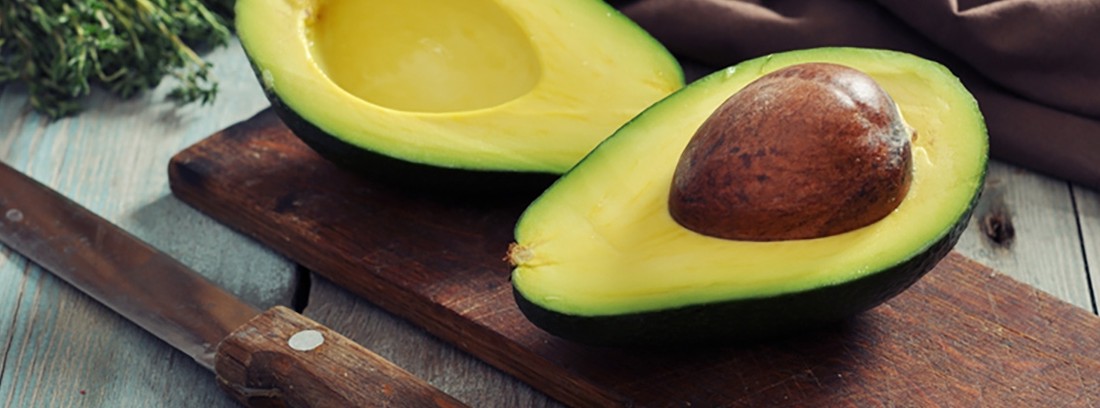Avocado, the »green gold».
 WHAT YOU NEED TO KNOW ...
WHAT YOU NEED TO KNOW ...
- The avocado season will depend on the variety we choose: the strong is available all year, the pinkerton is typical of February and March, and the autumn bacon.
- It is an energetic product, rich in monounsaturated fatty acids and vitamin E.
- It is ideal for athletes, children, pregnant and lactating women, diseases with cachexia or anorexia, potassium deficiencies, etc.
Fat but very healthy
Its composition is basically water and fat, which makes it very different from most fruits. For 100 grams of avocado we ingest about 140 kilocalories, especially from monounsaturated fatty acids. The weight of this fruit is highly variable depending on the type, but it usually ranges between 150 and 350 g, from which we have to subtract the skin and the central bone, generally quite heavy.
Avocado contains about 76 g of water per 100 g, 1.8 g of protein, 0.8 g of carbohydrates or carbohydrates, and 14.2 g of fats, of which more than half are monounsaturated fatty acids. Regarding micronutrients, potassium, vitamin E and folic acid stand out.
How to take it
The creamy texture of avocado makes it suitable for spreading on bread or toast as an appetizer. It can be taken alone or with ingredients that enhance its flavor, such as the famous guacamole. It combines well with salads, accompanied by a variety of crunchy vegetables that contrast with the smoothness of the avocado. Its unctuousness also makes it perfect to complete cream sauces or vinaigrettes.
WHO IS SUITABLE AND WHO IS NOT?
It is recommended for:
- People with high energy needs. Children, athletes, pregnant and lactating women can benefit a lot from the nutritional properties of this food. Vitamin E, with antioxidant potential, the energy supply mainly based on monounsaturated fatty acids, its folic acid content, etc.
- In people who for different reasons have low potassium levels, take diuretics, have vomiting episodes, etc., this food can be very useful to counteract these deficiencies.
- Patients with anorexia and / or cachexia. There are times when the intakes are insufficient for the energy needs of the person, so in these cases we will have to look for foods that provide a large amount of nutrients in a small volume of food. The avocado is a clear example. In addition, the type of fats that it provides make it an excellent food.
- People with. Although its high energy content means that we should not abuse its consumption, its contribution of monounsaturated fatty acids and vitamin E make it an ally to prevent cardiovascular diseases.
It is not suitable in case of:
- Overweight or obese The caloric content of avocado means that its consumption should be moderate in cases where it is necessary to restrict the energy intake of the diet.
- People with kidney disease. Due to the amount of potassium it provides, its consumption is inadvisable in kidney patients who require a limitation in the potassium content of the diet.
REMEMBER THAT…
To open an avocado you have to cut it from top to bottom, deepening the cut to the central bone and turning the fruit all the way around. Then we turn the two parts in the opposite direction and the bone will come off one of them, to remove the bone we can give a sharp blow with the blade of a knife so that it is nailed longitudinally. Next, we hold half of the avocado and rotate the knife until the bone is released.
If we are not going to consume the avocado immediately we must avoid its oxidation by sprinkling it with lemon juice.
Buying and conservation advice
The first thing we will do before choosing an avocado is to carry out a visual check. We will discard specimens that present bumps, spots on the skin, etc. As for the touch, if we want to choose a good specimen, we must reject those that present excessively firm consistency and also those whose skin is deformed when pressed slightly, which will indicate a too advanced state of maturity. When pressed with your finger, it should feel slightly soft. In this case, it will be ready to consume immediately or in a maximum of three days as long as we keep it at room temperature.
If we want to accelerate the ripening of the avocado, it can be stored together with fruits such as apples, pears, bananas or peaches, since they release ethylene and intensify the ripening of those around them. If, on the contrary, we want to keep it for longer, we will slow down its maturation if we keep it in the fridge in the least cold part (bottom drawer or on the door). It is not advisable to keep it below 6 degrees, and in any case we would not be able to increase its useful life by more than 5-7 days. If we want to keep it for longer, we must extract the pulp, mix it with lemon juice and freeze it.
THE RECIPE
Couscous salad with avocado and basil
Ingredients
- 100 g canons
- 2 cups of raw couscous
- 2-3 avocados
- 2-3 tomatoes
- 1 spring onion
- Basil and olive oil
Preparation
Cook the couscous and reserve it. Chop the tomato and chives. Open the avocado and extract the pulp into small balls. If we present it in a bowl, mix all the ingredients, but if we do it in a source, the base will be the couscous, and on it we will distribute the tomato and chives and, on top, the lamb's lettuce and avocado. Finally, sprinkle with basil and dress with olive oil. Serve immediately to avoid oxidation of the avocado.
We propose other ideas to surprise your family.
(Updated at Apr 14 / 2024)